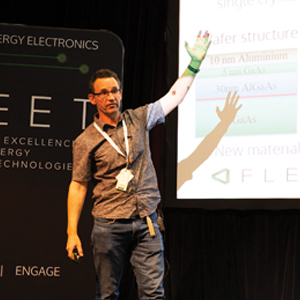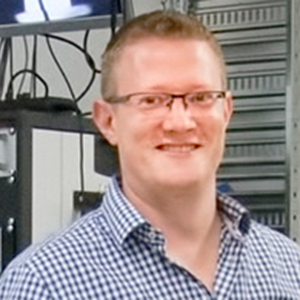
Case
Study
Tracking unexpectedly-fast
conduction electrons
FLEET study used scanning tunneling microscope (STM) ‘trick’ to map electronic structure in the topological material Na3Bi, seeking an answer to its extremely high electron mobility
A 2020 study unlocking the ultra-high electron mobility of topological Dirac semimetals was an exciting step towards use of these materials in future low-energy electronics.
A topological insulator (such as Na3Bi) allows one-way electrical conduction along its edges
Before this study, little was known about conduction-band dispersion in Na3Bi, although there had been tantalising hints that the actual velocity of electrons was much larger than theoretical predictions.
High electron mobility is key to this material’s potential for ultra-low-energy devices.
“To solve this mystery, we grew thin films of Na3Bi and investigated their band structure via quasi-particle interference,” says lead author FLEET Research Fellow Dr Iolanda di Bernardo (Monash University).
One of the few ways conduction bands can be mapped in such materials is using an STM ‘trick’ borrowed from spectroscopy.
“We ‘map’ quantum tunneling current between the STM tip and the sample at different voltages,” explains Iolanda.
Mathematical analysis of the resulting electron-scattering signal reveals circular energy contours, and reconstruction of (linear) band dispersion in the material indicates electron velocities.
These measured electron velocities in the low-lying conduction and valence bands were significantly higher than theoretical predictions, but the team found one way to significantly improve agreement between measurement and theory.
“We used increasingly complicated models to describe our system, and discovered that as we more-closely modelled exchange and correlation potential, we got closer to the experimental values,” explains Iolanda.
Thus the team confirmed that exchange and correlation effects are crucial to electron mobility in Na3Bi.
Topological Dirac semimetals can be considered three-dimensional (3D) counterparts of graphene: their conduction electrons display the same linear band dispersion as graphene, meaning their electrons are virtually massless.
This, naturally, translates into extremely high conductivity, which in topological Dirac semimetals, unlike in graphene, occurs in all three directions in space.
Understanding the ultra-high mobilities of carriers in topological Dirac semimetals is a step towards successfully implementing these materials in devices for low-energy electronics.
This research relates to FLEET milestones 1.1 and 1.2. See page 13 of Strategic Plan
The study was published in Physical Review B in July 2020 (see Publications)
The exciting thing about condensed-matter physics is when all the pieces of the puzzle come together and you learn something from it.
Lead author FLEET Research Fellow
Dr Iolanda Di Bernardo (Monash)
Did you know...
The semiconductor industry decadal plan 'seismic shift #5' identifies a mis-match between the growth of computing and available energy capacity.



